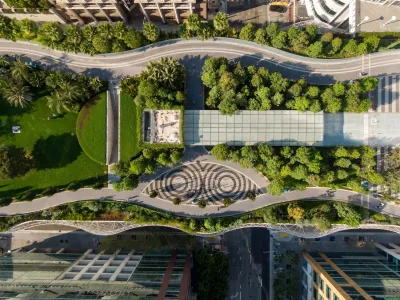San Francisco incorporates green infrastructure in its city development initiatives, elevating the importance of sustainability in urban planning.

Seeking to prioritize sustainability, San Francisco incorporates green infrastructure in its urban planning initiatives. According to The Daily Californian, these initiatives include “improving water quality, creating sustainable urban landscapes and managing stormwater.”
Diverging from traditional forms of green infrastructure, San Francisco aims to include diverse sustainable approaches in its city development projects. The Daily Californian reports, “When people hear the term 'green infrastructure,' they may picture green-painted (or planted) rooftops, a modern urban design approach that has been quickly implemented in cities across the country. However, green infrastructure encompasses a wide range of strategies beyond green rooftops, all of which support a city’s long-term sustainability.”
By utilizing green infrastructure, San Francisco desires to include “... a diverse collection of measures that incorporate natural systems and biomimicry techniques in order to store stormwater and reduce its flow into sewer systems and/or contamination of surface water.” The Daily Californian highlights that “... stormwater poses a huge challenge to water quality in the United States, as substances like motor oil, gasoline and toxic chemicals get caught in its runoff, adversely affecting biodiversity and human health.”
In response, San Francisco is launching the Sunset Boulevard Greenway project. According to The Daily Californian, “the San Francisco Public Utilities Commission, or SFPUC, has spearheaded a 20-year, multibillion-dollar project known as the Sunset Boulevard Greenway. The project runs 12 blocks on Sunset Boulevard, boasting 30 rain gardens and managing 5.3 million gallons of stormwater annually. Plants and soils native to the region work to absorb water and reduce the quantity of runoff entering the sewer system.”
Overall, by integrating innovative green infrastructure strategies into its urban planning projects, San Francisco ensures environmentally sound initiatives and sustainable urban development for its residents and the surrounding landscape. These implementations will “... serve as a mechanism to boost climate resiliency and make large metropolitan areas more sustainable as we continue forward into the 21st century.”
FULL STORY: Green Infrastructure Revolutionizing SF’s Urban Planning

Maui's Vacation Rental Debate Turns Ugly
Verbal attacks, misinformation campaigns and fistfights plague a high-stakes debate to convert thousands of vacation rentals into long-term housing.

Planetizen Federal Action Tracker
A weekly monitor of how Trump’s orders and actions are impacting planners and planning in America.

San Francisco Suspends Traffic Calming Amidst Record Deaths
Citing “a challenging fiscal landscape,” the city will cease the program on the heels of 42 traffic deaths, including 24 pedestrians.

Defunct Pittsburgh Power Plant to Become Residential Tower
A decommissioned steam heat plant will be redeveloped into almost 100 affordable housing units.

Trump Prompts Restructuring of Transportation Research Board in “Unprecedented Overreach”
The TRB has eliminated more than half of its committees including those focused on climate, equity, and cities.

Amtrak Rolls Out New Orleans to Alabama “Mardi Gras” Train
The new service will operate morning and evening departures between Mobile and New Orleans.
Urban Design for Planners 1: Software Tools
This six-course series explores essential urban design concepts using open source software and equips planners with the tools they need to participate fully in the urban design process.
Planning for Universal Design
Learn the tools for implementing Universal Design in planning regulations.
Heyer Gruel & Associates PA
JM Goldson LLC
Custer County Colorado
City of Camden Redevelopment Agency
City of Astoria
Transportation Research & Education Center (TREC) at Portland State University
Jefferson Parish Government
Camden Redevelopment Agency
City of Claremont


























